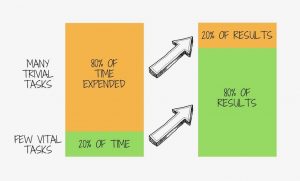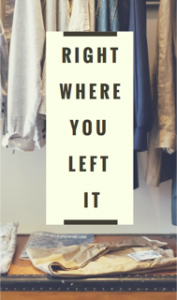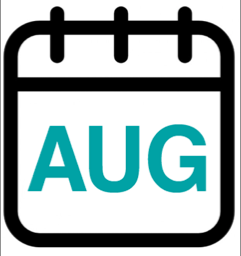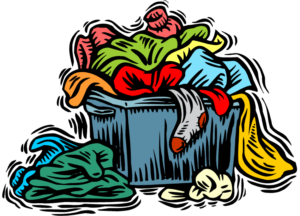 Have you ever gotten to the end of your day wondering what (if anything) of value you actually accomplished? If so, it may be time to pull out the 80/20 Rule!
Have you ever gotten to the end of your day wondering what (if anything) of value you actually accomplished? If so, it may be time to pull out the 80/20 Rule!
Professional organizers often apply the 80/20 Rule (a.k.a., the Pareto Principle or the Law of the Vital Few) to decluttering. For example, in a closet, determine the 20% of clothes you wear 80% of the time, purge the 80% of clothes you seldom or never use, and – voila! – you have space for clothes more like your favorite few.
The principle also applies to time. Most of us accomplish 80% of our best work in just 20% of our time, and fritter away 80% of our time doing…what? The key to really accomplishing our goals, to really making an impact, is to focus on the 20% of things we are really good at.
Determining our best 20% when it comes to clothes is pretty straightforward: pull everything out of the closet and start sorting: things I love (or not), things that fit (or not), things that make me look great (or not), etc.
But how do we determine our best 20% when it comes to work? Claire Diaz-Ortiz, in the book Design Your Day, suggests this similar pull-out-and-sort activity to find out:
First, get two pieces of paper. At the top of one write “Big Wins” and on the other write “Activities.”
On the “Big Wins” paper, list things that you’ve done in the past few years, personally or professionally, that have brought you the greatest joy, that have made you feel most alive, that have made you feel like you were in the sweetest of sweet spots. These could be things that happened just once, or continuing things.
On the “Activities” paper, list absolutely everything you do on a regular basis – fun or not fun, significant or not significant, necessary or unnecessary, whatever. Then sort these items into three categories: Things Only I Can Do, Things Someone Else Can Do, and Things I Should Stop Doing. (It might help to rewrite your activities on a fresh piece of paper with three columns headed with these categories.)
Next, cross-check. Things that appear on both your “Big Wins” list and your “Things Only I Can Do” list are your best 20%!
Now, set priorities:
As Diaz-Ortiz says, “ultimately, this activity is a mind-opening way to see where your time and work is really moving the needle and where you’re just running on the hamster wheel to stay busy.”
Let 2018 be the year where you focus on the few vital tasks that best get you to where you want to be.
80/20 your 2018!
 If being organized is not how you were raised but you’ve started to become more orderly, you may already know: it takes time getting used to “being organized.”
If being organized is not how you were raised but you’ve started to become more orderly, you may already know: it takes time getting used to “being organized.”
I learned this with a new client: Kim (not her real name) has struggled all her life to maintain a neat space. Her efforts go in waves and she has managed to live a really rich and creative life — but it hasn’t been easy. She’s lost a few things along the way. Paid her share of late fees for bills and penalties for misplaced parking tickets. And wasted time rewashing clothes after the dirty commingled with the clean.
When she was ready to stop this chaos…she called in a professional organizer.
She had 3 areas to organize:
• her wardrobe and bedroom
• her living room – including a desk area
• her hallway which had become an over-crowded storage space
We started in her bedroom because the mess was affecting her sleep. After 3 working sessions we had sorted through all of her clothes, cleared every surface (including the floor) of anything that didn’t belong, rearranged her dresser drawers and closet with zones for each type of clothing she needed in her life.
Moving on to the living room, Kim sheepishly told me a “funny” story about her missing slippers. The one constant in Kim’s life had been lots of weekends away to cabins with friends. In preparing to pack for one such weekend, she described how she had scoured her apartment looking for her slippers.
She checked ALL of her usual spots: under the coffee table, in the bathroom, kicked under the hallway table, in a pile behind the couch, tucked under her bed, tossed into a corner by her cat…she couldn’t find them anywhere.
She left for her weekend sans slippers in a bummed mood.
As soon as she got on the road to the cabin, it hit her. She couldn’t help but laugh out loud. Her slippers were right where we had left them — in their new home. They were in the bottom “bay” of the hanging shoe organizer we had installed in her closet.
It was a funny lesson to us both, that getting organized takes some getting used to! The motto of Kim’s story is: It’s easy to find what you need when you need it…when it is right where you left it.
I had a life-changing epiphany. It was on May 27, 1978 in the wee hours following opening day of Atlantic City’s first casino, Resorts. My then-boyfriend and I were there until the casino closed (pre-24-hour operation). We drove around Atlantic City, off the main roads. I was stunned to see truly deplorable living conditions. I felt guilty about all I had and didn’t fully appreciate.
My epiphany? I would never again complain about things I didn’t have – I had everything I needed and much of what I wanted.
I’ve kept that promise. In fact, a few years ago I stopped buying stuff I didn’t need and avoided shopping centers. Maybe it was due to organizing and downsizing other people’s stuff, sometimes massive amounts. Or because I didn’t want more stuff. Probably both, plus Pareto’s 80/20 Rule: We use 20% of our things 80% of the time.
I don’t mean to sound like a scrooge. If you’re OK with your amount of stuff, have enough space, can afford and enjoy buying new things, and your life is not negatively impacted, that’s great!
But if you feel as I do, walk around your house, take a mental inventory and ponder these questions before buying more things.
Now when I shop for something new (who doesn’t like new things sometimes?), I focus on my goal and try to avoid aimless browsing – you know, how guys shop. I discovered it’s liberating being free from societal and marketing pressures to buy more, or the latest whatever, to be happy. You too can buck the gotta-have-more, gotta-have-it-now mentality with a change in perspective. You can do it yourself or with help from an organizing consultant.
I am truly happy with the many beautiful things I own. I have more than some and less than others. But I have more than enough. I’ll never own an Aston Martin and I’m OK with that!
My Evernote conversion occurred about five years ago. Stuffed in the back of my junk drawer (yes, I also have one) for several years, lay a handwritten recipe for the best maple balsamic salad dressing obtained from a restaurant in Vermont. Frustrated with my lack of organization for something so valuable, I downloaded Evernote and my life was forever changed.
I created a notebook in the Evernote app and titled it “Recipes,” took a photo of the recipe within the Evernote app et voila! Wherever I am, on my phone, tablet or laptop I have a screenshot of the recipe. I quickly saw how transformational this would be in both my personal and professional life. When a friend recommends a great restaurant, it goes into the notebook I created titled “Recommended Restaurants”. I also do this for movies, books, wine, travel destinations, decorating ideas. All those great details we scribble on the back of napkins never to find again.
If I’m surfing the web, I can use Evernote webclipper to clip an article or page and put it into the notebook of my choice. I can also dictate notes into Evernote and draw using the Skitch app.
I also have a notebook for each of my kids. I have a screenshot of their health insurance cards, health records, photos of their artwork from Kindergarten so I could get rid of those large poster-size monstrosities, er, I mean works of art. The list goes on.
For my business, I’m able to share notebooks with my team and with our clients. We often take notes during an organizing session and share these with our clients. Evernote also eliminates the need to email documents back and forth. Instead, the whole team can collaborate and has access whether they are working remotely or in the office to notes, documents, photos, etc.
I’m barely scratching the surface of Evernote’s endless possibilities. For more information and to create your free online account check out www.evernote.com
 Have you ever heard of BOGO? What about FOMO or YOLO?
Have you ever heard of BOGO? What about FOMO or YOLO?
These acronyms are clever and catchy:
BOGO: Buy One, Get One is an advertising phrase that encourages people to purchase because of the promise of a second item…whether they need it or not.
FOMO: Fear Of Missing Out is a phenomenon where people refuse to commit to plans or feel less present in their current activity because they wonder what they’re missing (that might be more fun).
YOLO: You Only Live Once is my youngest daughter’s favorite.
Ever heard of AUG? Don’t worry if you haven’t. Other than being the abbreviated version for this month, it is my attempt to be clever by encouraging de-cluttering throughout August. AUG stands for Anything Unused Goes!
AUG is an acronym that is very flexible. I invite you to get creative with the different ways you can use it to clear unused, useless and unworthy things from your life, space and storage areas.
How do you decide worth or usefulness? Please don’t decide worth solely by how much you spent or invested in something. Real worth is defined by how valuable it is to you today. Decide how necessary your stuff is to your life and its worth of the space it’s taking up in your home, car or office.
Lots of folks confuse usefulness with an item’s ability to still be useful – without considering if that item is of actual use to them. Today, there are so many ways to donate, repurpose and recycle things. Don’t hold onto things that clutter YOUR life. Let Anything Unused Go!
 Looking for a way to shed a few pounds this summer? If you start with your home, you will gain more than weight loss benefits. Consider the excess weight that is in your home in the form of clutter. Clutter not only adds pounds, but drains your finances and takes a toll on you and your family – physically, mentally and emotionally.
Looking for a way to shed a few pounds this summer? If you start with your home, you will gain more than weight loss benefits. Consider the excess weight that is in your home in the form of clutter. Clutter not only adds pounds, but drains your finances and takes a toll on you and your family – physically, mentally and emotionally.
Take a guess at the approximate weight of these items (answers below):
By taking time to de-clutter your home this summer, you will enjoy these benefits.
Physical
Mental & Emotional
Financial
Shed some weight in your home this summer and you might find that the space you create promotes healthy changes in other areas of your life.
Answers to above: 1) 30 pounds 2) 15 pounds 3) 17 pounds.